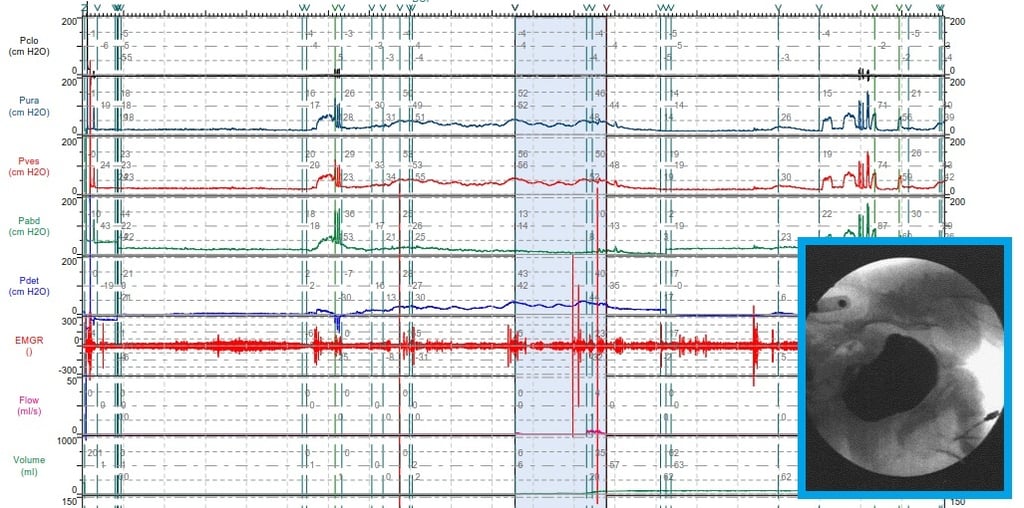Although urodynamic testing has been an important tool in diagnosing disorders of the urinary tract1, the tests and techniques have undergone minimal changes in the past few years. One recent development that has changed the way urologists, primary care physicians, and gynecologists diagnose disorders of the bladder and urethra is video urodynamics. Here, video urodynamics and traditional urodynamics are compared.
What is Traditional Urodynamics?
Traditional urodynamics includes the following tests:
- Postvoid residual urine volume
- Uroflowmetry
- Multichannel cystometry2
- Urethral pressure profilometry
- Electromyography
To perform these tests, a catheter is inserted into the bladder via the urethra and measurements such as urine volume, bladder pressure, rectal pressure, and muscle strength are recorded using sophisticated urodynamics equipment.
What is Video Urodynamics?
Video urodynamics involves urodynamic testing as described above but also leverages x-ray. The following tests can be performed with video urodynamics:
- Noninvasive uroflow
- Postvoid residual urine measurements
- Filling cystometrography
- Abdominal leak point pressure
- Voiding cystometography
- Electromyography
- Static cystography
- Voiding cystourethrography
During a video urodynamics test, the traditional urodynamic tests are performed (i.e. with the use of a catheter to fill the bladder and determine pressure differences, etc.); however, moving x-ray is used simultaneously in order to image the bladder and urethra for more complex measurements and additional visualization.
How do Video Urodynamics differ from Traditional Urodynamics?
Whereas during a traditional urodynamics test the filling medium for the bladder is water or saline solution, radiographic contrast is used for video urodynamics testing. In addition, video urodynamics requires a more expensive and elaborate setup, as well as specially trained clinicians. The procedure also typically takes much longer than traditional urodynamics. For women who are pregnant, video urodynamics is not an option.
However, video urodynamics can provide additional important details about a patient’s condition, particularly in the case of incontinence or bladder obstruction.
What are the Advantages of Video Urodynamics?
Video urodynamics can improve diagnostic accuracy3 for a patient whose condition is difficult to determine. For instance, video urodynamics allows for real time measurement of exact detrusor pressure during urinary leakage, and shows important images such as bladder outline which can help pinpoint more uncommon problems. When urinary incontinence is concerned, video urodynamics is superior because even small amounts of urinary leakage can be observed in conjunction with stress or bladder volume. Other advantages of video urodynamics over traditional urodynamic studies include:
- Electromyographic activity of pelvic floor muscles
- Dysfunction of smooth muscle in urethral sphincter
- Localization of urethral obstruction
- Improved interpretation of traditional urodynamic test results
- Determination of vesicoureteral reflux
- Determination of position of bladder neck at rest
- Inspection of urine leakage during stress
- Status of anterior vaginal wall support
As video urodynamics becomes more popular, additional benefits of this technique are likely to arise.
What are the drawbacks of Video Urodynamics?
While video urodynamics provides additional information over traditional urodynamic studies, it should be noted that this technique is not recommended for most patients. These tests are expensive and should be reserved for the most complex situations, after traditional urodynamics have been performed. Additionally, this procedure may be more embarrassing and uncomfortable for the patient, as the genitals must be handled and exposed throughout the procedure. Another drawback is that the treating physician should be present during the video urodynamics study in order to observe the real-time results. This significantly increases the innate costs of the procedure. Finally, due to the additional measurements and additional equipment setup, the procedure typically takes twice as long as a traditional urodynamics test, further increasing costs.
When are Video Urodynamics Appropriate?
Guidelines have been put forth to recommend when the use of video urodynamics is appropriate. Appropriate situations include when:
- Bladder neck obstruction is suspected
- Patients are at risk for neurogenic bladder
- Patients have relevant neurologic disease and high postvoid urine retention
- Patients have difficult-to-diagnose urinary incontinence
When are Traditional Urodynamics Appropriate?
Traditional urodynamics are most appropriate for almost all simple lower urinary tract questions that need addressing. For instance, questions of postvoid urine retention, urine flow, and abdominal pressures are best left to traditional urodynamics. Only when additional information is required, or there is difficulty in determining the exact location of bladder obstruction should more complex tests be performed. Ultimately, one of the biggest limitations for video urodynamics testing currently is proper patient selection.
Money, time, and resources can be needlessly wasted when this choice is not properly made, so judicious consideration must be utilized. According to a 2013 study4, “traditional” urodynamic testing is still the gold standard to objectively evaluate lower urinary tract function.
If your practice is not currently providng urodynamics or you would like to provide urodynamics at additional locations across your organization, click on the button below to find out how.
If you would like staffing services to help your organziation provide urodynamics or video urodynamics, click here.
If you liked the above article, you may also like our blog article Urodynamics in Benign Prostatic Hyperplasia (BPH) Patients.
References
- Abdul-Rahman, A., Al-Hayek, S., & Belal, M. (2010). Urodynamic studies in the evaluation of the older man with lower urinary tract symptoms: when, which ones, and what to do with the results. Therapeutic Advances in Urology, 2(5-6), 187–194. http://doi.org/10.1177/1756287210385924. Link
- Sutherst, J. R., & Brown, M. C. (1984). Comparison of single and multichannel cystometry in diagnosing bladder instability. Bmj, 288(6432), 1720-1722. doi:10.1136/bmj.288.6432.1720 Link
- Marks BK, Goldman HB. Videourodynamics: indications and technique. Urol Clin North Am. 2014;41(3):383–391. Link
- Rosier, P. F. (2013). The evidence for urodynamic investigation of patients with symptoms of urinary incontinence. F1000Prime Reports, 5, 8. http://doi.org/10.12703/P5-8 Link


